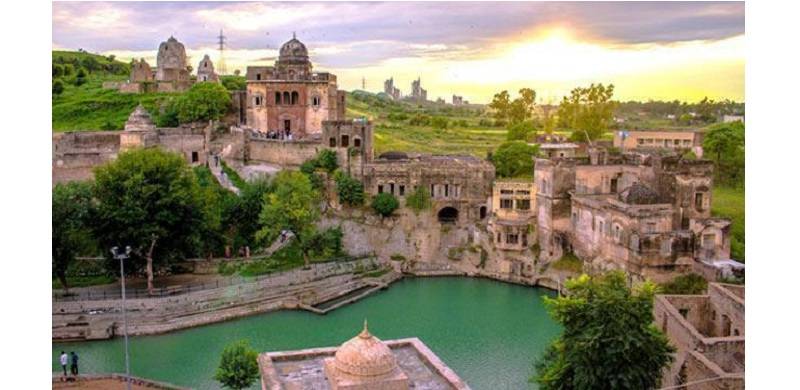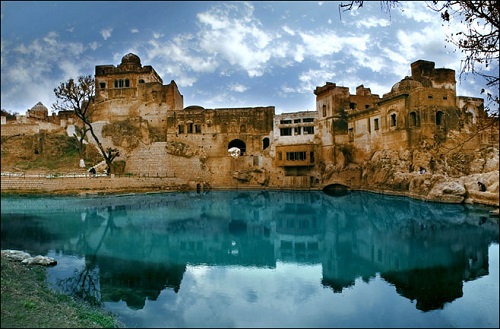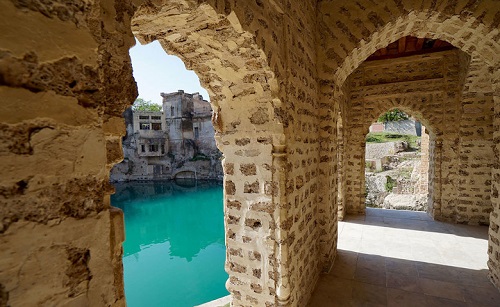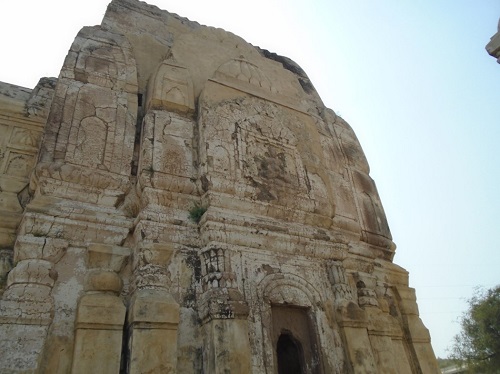
The history of Punjab can be traced in the pre-Islamic era from the Indus valley civilisation to the Hindu Shahi era, especially in the northern part of the region. The Hindu Shahi dynasty ruled in Punjab from 1001 AD to 1026 AD. Its founding ruler was Kallar, whose name has since been given to many places, as in the Kallar Syedan tehsil and Kallar Kahar in Rawalpindi division. The last Hindu Shahi ruler was Bhimpala, who was defeated by Mahmud of Ghazni.
During the rule of the Hindu Shahi dynasty, a number of palaces were built in various districts of Punjab, but especially so in the modern-day division of Rawalpindi. The district of Chakwal is famous for sites associated with this era. One of these sites, the Katas Raj temple complex, is a particularly valuable mark of the dynasty – though the temples themselves date back to earlier periods.
 The Katas Raj temples are located in the village of Katas Raj near the city of Choa Saidan Shah, on the Kallar Kahar road, Chakwal. The temples are sacred spaces of the Hindu religion. This is a complex of temples which were erected in various periods of time, by different rulers as dedications to the gods. “Katas Raj” the name is derived from the Sanskrit word “Kataksha” meaning “tearful eyes.” It is believed that Lord Shiva stayed there, mourning his wife Sati. In her memory, he shed tears which are today the pond of Katas, around which the temple complex stands. This pond contributes greatly to the stunning beauty of the temples. Hindu pilgrims bathe in the scared water on holy occasions to seek forgiveness of sins and purify themselves.
The Katas Raj temples are located in the village of Katas Raj near the city of Choa Saidan Shah, on the Kallar Kahar road, Chakwal. The temples are sacred spaces of the Hindu religion. This is a complex of temples which were erected in various periods of time, by different rulers as dedications to the gods. “Katas Raj” the name is derived from the Sanskrit word “Kataksha” meaning “tearful eyes.” It is believed that Lord Shiva stayed there, mourning his wife Sati. In her memory, he shed tears which are today the pond of Katas, around which the temple complex stands. This pond contributes greatly to the stunning beauty of the temples. Hindu pilgrims bathe in the scared water on holy occasions to seek forgiveness of sins and purify themselves.
Some scholars guess that the construction of the temples of Katas Raj was in the early period of the Mahabharata and it is associated with the birth place of Lord Rama. Hindu pilgrims believe that it is the second centre of worship in the historic region of Punjab, after the temple at Jawalamukhi in Himachal Pradesh, India. Pilgrims and devotees even today flock to pay their respects to the gods, coming from not just Pakistan but India, Sri Lanka and Nepal.
The architecture of the temples is distinctive and they are built in a square plan. There are a total of seven temples, each associated with particular deities. The architecture of the temples similarities with temples of Shiva built under Kashmiri influence: especially the raised pointed ceiling with half arches. Two temples were changed to accommodate the practices of Buddhism, becoming stupas. These were changed by Mauryan king Ashoka when he adopted Buddhism in the 3rd century BC. These temples have dentils with fluted pillars, and the entrances are trefoil arches with multi-pointed rooflines. All temples are erected around the Katas pond.
 There are also some modern constructions of buildings for the use of departmental offices and green parks for visitors. Many delegations of students, scholars and researchers from educational institutions across the country frequent the temple complex – in addition to domestic tourists from all religious traditions, and also foreign tourists. The site attracts those seeking a knowledge of the region’s historical treasures just as much as the devotees who seek to honour their gods and purify themselves.
There are also some modern constructions of buildings for the use of departmental offices and green parks for visitors. Many delegations of students, scholars and researchers from educational institutions across the country frequent the temple complex – in addition to domestic tourists from all religious traditions, and also foreign tourists. The site attracts those seeking a knowledge of the region’s historical treasures just as much as the devotees who seek to honour their gods and purify themselves.
During the rule of the Hindu Shahi dynasty, a number of palaces were built in various districts of Punjab, but especially so in the modern-day division of Rawalpindi. The district of Chakwal is famous for sites associated with this era. One of these sites, the Katas Raj temple complex, is a particularly valuable mark of the dynasty – though the temples themselves date back to earlier periods.
 The Katas Raj temples are located in the village of Katas Raj near the city of Choa Saidan Shah, on the Kallar Kahar road, Chakwal. The temples are sacred spaces of the Hindu religion. This is a complex of temples which were erected in various periods of time, by different rulers as dedications to the gods. “Katas Raj” the name is derived from the Sanskrit word “Kataksha” meaning “tearful eyes.” It is believed that Lord Shiva stayed there, mourning his wife Sati. In her memory, he shed tears which are today the pond of Katas, around which the temple complex stands. This pond contributes greatly to the stunning beauty of the temples. Hindu pilgrims bathe in the scared water on holy occasions to seek forgiveness of sins and purify themselves.
The Katas Raj temples are located in the village of Katas Raj near the city of Choa Saidan Shah, on the Kallar Kahar road, Chakwal. The temples are sacred spaces of the Hindu religion. This is a complex of temples which were erected in various periods of time, by different rulers as dedications to the gods. “Katas Raj” the name is derived from the Sanskrit word “Kataksha” meaning “tearful eyes.” It is believed that Lord Shiva stayed there, mourning his wife Sati. In her memory, he shed tears which are today the pond of Katas, around which the temple complex stands. This pond contributes greatly to the stunning beauty of the temples. Hindu pilgrims bathe in the scared water on holy occasions to seek forgiveness of sins and purify themselves.Some scholars guess that the construction of the temples of Katas Raj was in the early period of the Mahabharata and it is associated with the birth place of Lord Rama. Hindu pilgrims believe that it is the second centre of worship in the historic region of Punjab, after the temple at Jawalamukhi in Himachal Pradesh, India. Pilgrims and devotees even today flock to pay their respects to the gods, coming from not just Pakistan but India, Sri Lanka and Nepal.

The architecture of the temples is distinctive and they are built in a square plan. There are a total of seven temples, each associated with particular deities. The architecture of the temples similarities with temples of Shiva built under Kashmiri influence: especially the raised pointed ceiling with half arches. Two temples were changed to accommodate the practices of Buddhism, becoming stupas. These were changed by Mauryan king Ashoka when he adopted Buddhism in the 3rd century BC. These temples have dentils with fluted pillars, and the entrances are trefoil arches with multi-pointed rooflines. All temples are erected around the Katas pond.
 There are also some modern constructions of buildings for the use of departmental offices and green parks for visitors. Many delegations of students, scholars and researchers from educational institutions across the country frequent the temple complex – in addition to domestic tourists from all religious traditions, and also foreign tourists. The site attracts those seeking a knowledge of the region’s historical treasures just as much as the devotees who seek to honour their gods and purify themselves.
There are also some modern constructions of buildings for the use of departmental offices and green parks for visitors. Many delegations of students, scholars and researchers from educational institutions across the country frequent the temple complex – in addition to domestic tourists from all religious traditions, and also foreign tourists. The site attracts those seeking a knowledge of the region’s historical treasures just as much as the devotees who seek to honour their gods and purify themselves. 
